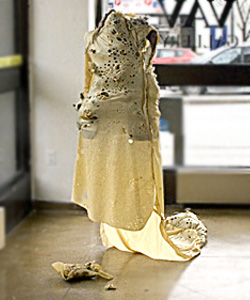AIDS course finds its way into VAV Gallery

Emma Howes' The Lipodystrophy Suit is used as part a performance that examines the visible signs of illness and social stigmas associated with them.
Photo by sabrina ratté - iits creative media services
Students who register for the interdisciplinary course on HIV/ AIDS may be prepared to discuss issues like sexuality and death in the classroom. They may even anticipate the emotional investment of the required internship in an AIDS organization.
However, social science students might not imagine participating in a show curated by their instructors.
Shown in the VAV Gallery from April 4 to 15, BaD_aRt: Desire, Sex and AIDS featured the work of over a dozen students registered for either the classroom or online version of HIV/AIDS: Cultural, Social and Scientific Aspects of the Pandemic. Some students performed their projects at the vernissage, which attracted over 200 people.
Co-instructor Tagny Duff, an interdisciplinary PhD candidate in Humanities, also has an MFA in studio arts. She said that over half of the students registered in the six-credit course opted to produce art as their final project, though not all of them chose to exhibit it.
Although the course is open to Fine Arts and Arts and Science students, not only art students chose a project over a paper . “Some of the Fine Arts students wrote the paper. They know how challenging it can be to produce a piece, as opposed to a 12-page paper,” Duff said.
The project alone requires three separate formal proposals, and subsequent meetings with Duff or co-instructor Christian Dare, who is finishing his third year with the course.
“Some of the Arts and Science students who participated in the show last year decided to become artists,” said Duff. “For students, the course can be life-altering.”
The course combines practical internship experience with guests who research, work and practice in the community. Three of them are invited under the auspices of the community lecture series on HIV/AIDS, which, like the course, is part of the Concordia HIV/AIDS Project.
The regular guests cover a range of topics and approaches. For many students, this may be their first exposure to pure science, or to community activism, depending on their background. Having access to such a diverse group of resource people opens up new possibilities for the students, the opportunity to be part of a juried art show being just one.
The vernissage also featured the work of Dont Rhine, a member of the California-based Ultra-red Collective. At an artist talk on April 5, Rhine discussed his early experiences with a needle exchange in Hollywood in the early 1990s.
As a sound artist, he was interested in how to combine art with his activism and looked for ways to document the impact of AIDS.
Over time, he grew dissatisfied with the activist model: “You define a point of conflict, develop an action and then move on.” He’s more interested in an “organizer” approach, one that works with and within a community towards long-term solutions.
Silent/Listen is the project he performed with Isabelle Noel on April 4 in the VAV Gallery. Four representatives of local AIDS groups briefly spoke about their organizations. Rhine immediately remixed their words.
Audience members were invited to join them at a table of microphones where they could share their feelings about the epidemic. The ensuing conversations were recorded and spliced together “as a document of where we are now,” in Rhine’s words.
Similar recordings have been made wlsewherre, and Ultra-red will be at the world AIDS conference in Toronto this summer. Rhine hopes documenting the current situation will help to develop a plan of action .